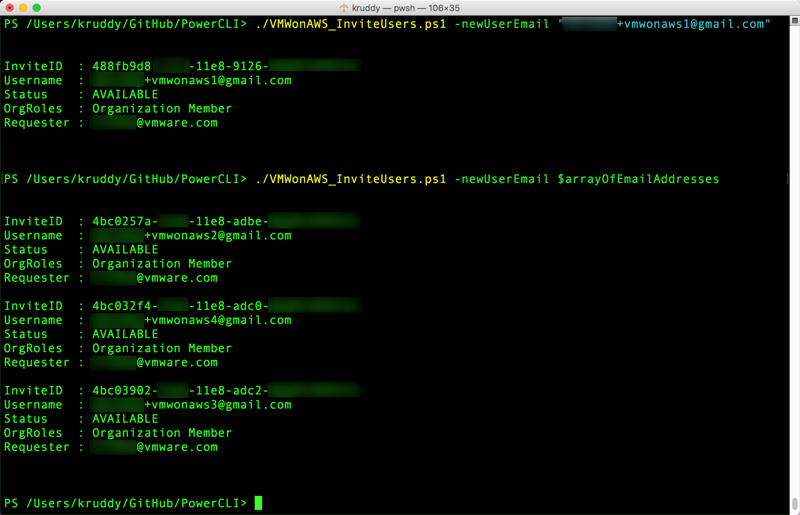PowerShell - Inviting Users to VMware Cloud on AWS Org
Recently, VMware Cloud on AWS announced the ability to create an SDDC with a single host. This is a pretty exciting update, one many of our users have been asking for. Along with the ability to deploy an SDDC in a much smaller footprint, you get access to all the automation and developer resources available such as the built-in Developer Center and the RESTful APIs.
In a post on the VMware Code blog, Automating VMware Cloud on AWS One Host SDDC Deployments, some code samples were debuted by Alan Renouf and myself to deploy a single host SDDC using direct REST calls, PowerCLI, and DCLI. This time, I’m focusing on automating the invitation process of users to the organization.
This too has been a big request from our users and we’re in luck, because there’s an API to accomplish this!
User Invitation Automation Script Overview
The script can be found on the PowerCLI Community repository and the VMware Code Sample Exchange titled ‘VMWonAWS_InviteUsers.ps1’. It uses PowerShell to make REST API calls directly to the VMware Cloud on AWS service in order to authenticate, create a new user request, then display the successful invite request along with some pertinent information. The ‘newUserEmail’ parameter accepts both string and array-based input then validates said input to verify it is indeed an email address. One item to note before downloading and running the script, you’ll need to update the variables on lines 28 and 29 with your API token and Org ID. With those updated, let’s check a couple examples of it in action!
User Invitation Script
<#
.SYNOPSIS
Takes email address input in order to create VMware Cloud on AWS invites for the desired Organization
.DESCRIPTION
Script which can be used to automate the process of adding new users to a specified VMware Cloud on AWS Organization
.NOTES
Author: Kyle Ruddy, @kmruddy, kmruddy.com
.PARAMETER newUserEmail
Plain text email address or array of email addresses
.PARAMETER roleName
Desired role name of the new users, default is Organization Member
.EXAMPLE
PS > ./VMWonAWS_InviteUsers.ps1 -newUserEmail 'testuser@vmware.com'
.EXAMPLE
PS > ./VMWonAWS_InviteUsers.ps1 -newUserEmail $arrayOfEmailAddresses
#>
[CmdletBinding(SupportsShouldProcess=$True)]
param (
[Parameter (Mandatory = $True, Position=0)]
$newUserEmail,
[Parameter (Mandatory = $False, Position=1)]
[ValidateSet("Organization Member","Organization Owner","Support User")]
[string]$roleName = "Organization Member"
)
# Set Static Variables for your environment
$oauthToken = 'xxxxxxx-xxxx-xxxx-xxxx-xxxxxxxxxxxx'
$orgID = 'xxxxxxx-xxxx-xxxx-xxxx-xxxxxxxxxxxx'
### DO NOT MODIFY CODE BELOW THIS LINE ###
$inviteReport = @()
$userEmail = @()
# Email Validation Testing
if ($newUserEmail -is [array]) {
foreach ($email in $newUserEmail) {
try {
$userEmail += [mailAddress]$email | select-object -ExpandProperty Address
}
catch {
Write-Warning "$email is not a valid email address"
}
}
}
else {
try {
$userEmail += [mailAddress]$newUserEmail | select-object -ExpandProperty Address
}
catch {
Write-Warning "$newUserEmail is not a valid email address"
}
}
if ($userEmail.Count -eq 0) {
Write-Warning "No valid email addresses found."
Break
}
# Validation and translation of the role name to the role ID
if ($roleName -eq 'Organization Member') {
$orgRoleNames = @("org_member")
}
elseif ($roleName -eq 'Organization Owner') {
$orgRoleNames = @("org_owner")
}
elseif ($roleName -eq 'Support User') {
$orgRoleNames = @("support_user")
}
# Creating custom objects to start building out the body input
$bodyObj = new-object -TypeName System.Object
$SvcRoleNames = @("vmc-user:full")
$SvcDefinitionLink = '/csp/gateway/slc/api/definitions/external/ybUdoTC05kYFC9ZG560kpsn0I8M_'
$bodyObj | Add-Member -Name 'orgRoleNames' -MemberType Noteproperty -Value $orgRoleNames
$serviceRolesDtos = New-Object -TypeName System.Object
$serviceRolesDtos | Add-Member -Name 'serviceDefinitionLink' -MemberType Noteproperty -Value $SvcDefinitionLink
$serviceRolesDtos | Add-Member -Name 'serviceRoleNames' -MemberType Noteproperty -Value $SvcRoleNames
$bodyObj | Add-Member -Name 'serviceRolesDtos' -MemberType Noteproperty -Value @($serviceRolesDtos)
$bodyObj | Add-Member -Name 'usernames' -MemberType Noteproperty -Value $userEmail
$body = $bodyObj | ConvertTo-Json -Depth 100
# Connecting to the REST API service for authentication and then to perform the POST method
$connection = Invoke-WebRequest -Uri "https://console.cloud.vmware.com/csp/gateway/am/api/auth/api-tokens/authorize?refresh_token=$oauthToken" -Method Post
$accesskey = ($connection.content | Convertfrom-json).access_token
$inviteUsers = Invoke-WebRequest -Uri "https://console.cloud.vmware.com/csp/gateway/am/api/orgs/$orgID/invitations" -headers @{"csp-auth-token"="$accesskey"} -Method Post -Body $body -ContentType "application/json"
# Outputting the successful invite which was just created
$orgInviteRefResponse = Invoke-WebRequest -Uri "https://console.cloud.vmware.com/csp/gateway/am/api/orgs/$orgid/invitations" -headers @{"csp-auth-token"="$accessKey"} -Method Get
if ($orgInviteRefResponse) {
$orgInviteRefObject = $orgInviteRefResponse | ConvertFrom-Json
foreach ($inviteRef in $orgInviteRefObject) {
$link = $inviteRef.refLink
$orgInviteResponse = Invoke-WebRequest -Uri "https://console.cloud.vmware.com$link" -headers @{"csp-auth-token"="$accessKey"} -Method Get
$orgInviteObject = $orgInviteResponse.content | ConvertFrom-Json
foreach ($emailInput in $userEmail) {
if ($orgInviteObject.username -eq $emailInput) {
$i = New-Object System.Object
$i | Add-Member -Type NoteProperty -Name InviteID -Value $orgInviteObject.refLink.Substring($orgInviteObject.refLink.Length - 36)
$i | Add-Member -Type NoteProperty -Name Username -Value $orgInviteObject.username
$i | Add-Member -Type NoteProperty -Name Status -Value $orgInviteObject.status
$i | Add-Member -Type NoteProperty -Name OrgRoles -Value ($orgInviteObject.OrgRoleNames -join ", ")
$i | Add-Member -Type NoteProperty -Name Requester -Value $orgInviteObject.generatedBy
$inviteReport += $i
}
}
}
}
return $inviteReport
Overview
VMware Cloud on AWS has an immense amount of functionality available through RESTful APIs, including methods to manage users within our Organization! In this blog post, we covered a newly released script which helps to automate the process of inviting new users. Download the script from the VMware Code Sample Exchange today!

